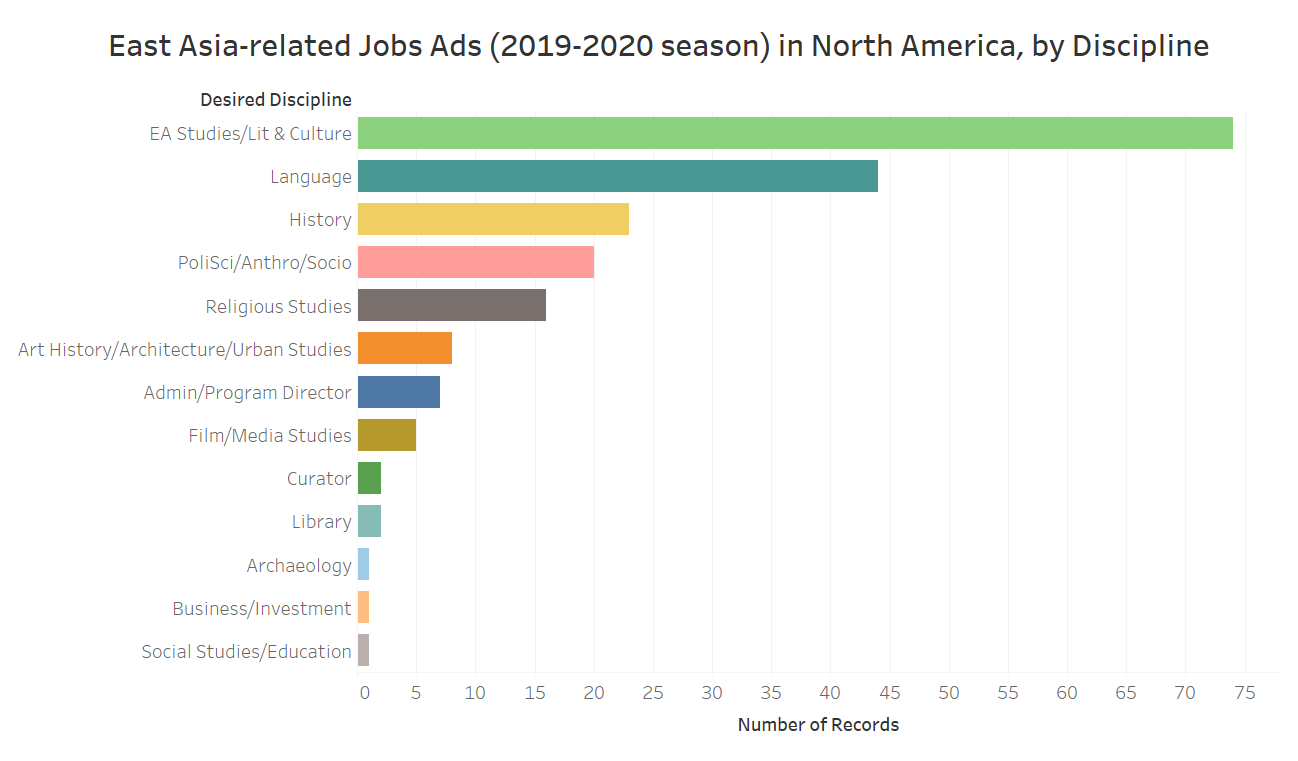Virtual Roundtable: The “Rebirth” of Japanese Studies
Melinda Landeck, Austin College
Melinda Landeck received her doctorate in East Asian History from the University of Kansas and also holds a master’s degree in East Asian Studies from Yale University. Since 2016, she has been an tenure-track assistant professor of East Asian Studies at Austin College, a private liberal arts college located north of Dallas.

Insofar as the data reveals that Japanese Studies positions are shrinking nationally, precisely where are the jobs that remain? My comments will address one of the key findings of Paula’s excellent data-mining: and that is the comparatively robust employment niche represented by interdisciplinary East Asian Studies programs housed in teaching-oriented institutions such as small liberal-arts colleges, or SLACs.
I hope to share some insights into the opportunities presented by employment at teaching-oriented SLACs and other small schools. I will also address the ways in which largely R1 doctoral programs can better prepare new PhDs for the changing landscape of the Japanese Studies job market in this moment of rapid metamorphosis. Finally, I would like to share some of the specific measures we are working on at my home institution to safeguard the continued vitality of our East Asian Studies program.
Some personal background: I am now a fourth-year junior faculty member on the tenure track in an interdisciplinary East Asian Studies program housed at Austin College, a private SLAC in north Texas, where I teach intermediate Japanese language courses in addition to a wide range of both Japan-specific as well as transregional courses on East Asian history, culture, literature and cinema. My institution has an enrollment of fewer than 2000 students and has recently been in the enviable position of experiencing enrollment growth thanks in great part to a regional demographic boom in college-bound high school graduates. Our mostly-undergraduate students are majority-minority, and while some hail from the wealthy suburbs of Dallas, Houston, and Austin, we have many more first-gen, Pell-eligible and, given our status as a border state, undocumented DACA students on our campus.
Even before the current COVID-19 crisis threw all of higher education into an unprecedented tailspin, my college was proactively addressing multiple worrying trends that are common across higher ed: declining numbers of humanities majors, challenges in student retention, and, even at an institution which has historically never relied heavily on contingent faculty, an emerging pattern of not replacing retiring humanities faculty lines.
For context, I am the product of two large state universities where I earned my BA and doctoral degrees and an Ivy League institution where I received a master’s degree. I had precisely zero experience with private liberal arts colleges when I went on the job market in 2015 with a newly minted PhD in early modern Japanese history. I did fairly well in the search, participating in 10 interviews and securing five campus visits, culminating in two tenure-track job offers. While my R1 doctoral program prepared me well for employment at an R1 institution, it did not seem to have the same resources to advise me in navigating the job market and hiring experience at a SLAC, an environment in which the tenure expectations, terms of employment, and nature of the day-to-day job can look remarkably different from those at an R1. To just share one example, well-meaning mentors from my degree institution urged me to negotiate for a pre-tenure sabbatical, something that simply has no precedent at my teaching-oriented college whatsoever. Insofar as our internal bar for tenure does not stipulate that you produce a book-length publication, focusing instead on excellent classroom instruction, institutional service, and a demonstrable engagement with one’s field, it hardly seems necessary.
The fact is that from the moment I stepped onto my current SLAC campus, I felt very much at home. After more than two decades of working in large state institutions, the alacrity of movement and ability to leverage personal relationships in a highly interconnected small institution appealed to me greatly. Thanks to the smaller size of our institution and its deep commitment to student-centered learning and ongoing professional development, I have been enabled to develop more compelling courses, design and quickly implement innovative pedagogies, and personally mentor students in meaningful ways that I can scarcely imagine being feasible at larger institutions with deeper financial pockets but more siloed departmental structures. It has, in short, proved a wonderful place to work.
My recommendation to the next generation of would-be Japanese studies scholars is that, in the course of applying for absolutely everything out there (more a necessity now than ever), to remain tremendously open to jobs at teaching institutions, and actively strive to develop a robust teaching profile. You may, like me, find them a better fit than you dared to imagine. Conversely, I would urge senior faculty training the next generation of Japan scholars to consider that the realities of today’s job market, as well as the financial burdens of the new PhDs entering it, may differ radically from those which defined your own experiences, even if it happened within the past decade. Please encourage your students to apply to a wide variety of jobs and bear in mind that R1 norms do not universally apply to all of them. As the data reflects, the market for generalist, area-studies, or cultural positions is growing rapidly in contrast to the sorts of geographic or period specializations to which most placement efforts remain oriented. The resulting mismatch between expectations and a shifting reality should not lead rising scholars, or their mentors, to discount the rewards and appeal of such positions.

I will turn now to the internal measures we have taken to keep our East Asian Studies program vital. Our efforts have taken a two-pronged approach: one focused on the external marketing of the East Asian Studies major or minor to students, their parents and potential employers, and the other focused on internal bridge-building initiatives that connect EAS to other programs across departmental and divisional divides.
One particular strategy has been to make sure that a significant number of the courses that EAS faculty teach address broader institutional needs for courses that focus on foreign language, writing-credit and global diversity courses. We have committed our department to servicing our new institution-wide writing curriculum via the same core courses that often attract new students into our major and minor programs. We are among the primary providers of courses for a newly implemented global diversity requirement, further signaling our value to the institution as a whole. Another internal push has been to develop courses that may be cross-listed with other departments within and outside of the humanities division. Examples include Environmental Issues in East Asia (cross-listed with environmental studies), Women in Modern Japan (cross-listed with gender studies), and Chinese medicine (cross-listed with public health to serve our large population of pre-med students). Such measures not only keep our enrollments robust, but also provide helpful visibility in a school where up to 40% of new freshmen are in our pre-med program.
These measures have been augmented by a divisional push to document linkages between humanities degrees with transferable job skills and satisfactory career outcomes. This initiative addresses itself to the concerns of students and parents that a degree in East Asian Studies (or English, or philosophy, etc.) will not assist them in the process of workforce entry or their long-term professional trajectory, even though the experiences of our Humanities graduates tells a very different, and much more positive, story. This program focuses on articulating how humanities courses help students to develop five core leadership and critical thinking skills valued by employers, connects successful EAS alumni at various stages of their careers in the nonprofit, legal, corporate, or government sectors to current students, and ultimately seeks to create paid summer internship opportunities for our students.
I will conclude by raising a couple of questions that I hope others may take up in their responses:
- How do we balance the burden that area-studies faculty take on to service broad institutional needs with the challenges posed by the lack of new or replacement tenure lines, slow erosion of our tenured-to-contingent ratio, and the continually expanding workloads that forestall the advance of personal research agendas?
- How do we make a compelling case for studying Asia to new undergraduates ? To our eyes, the crucial importance of East Asia in global geopolitics may seem self-evident , but parents making a six-figure investment in their child’s undergraduate education want to see a clear through-line to the first few jobs their student may land after graduation.
- In teaching transregional courses outside of our geographical specializations, how do we avoid succumbing to superficial teaching of content on areas outside of our core training?
In this uncertain moment, it is clear to me that that societal value of the critical thinking skills we impart to students as educators is higher than ever. And while the pandemic poses an all-too-tangible threat to the work we strive to do at institutions of all kinds and sizes, we should take some comfort in knowing that what we do imparts crucially important skills to the students we serve. We must continue to advocate and fight for more than just the survival of our field, but must, in the spirit of this panel, consider ways to ensure that it continues to invent itself anew.